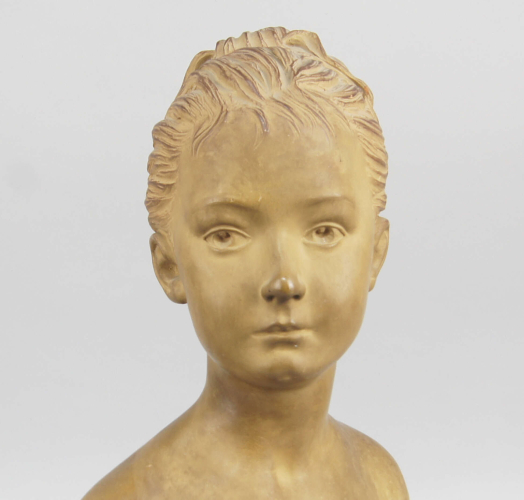The neoclassical sculptor Jean Antoine Houdon was born in Versailles, France in 1741. His family were servants in the Royal household of the Bâtiments du Roi, and his father’s position as concierge of the École des Élèves Protégés allowed the young Houdon to gain experience in the premier studios of the capital while apprenticed to the sculptor René-Michel Slodtz. The École was a preparatory school for Prix de Rome recipients, a prize for emerging artists to travel to the Italian capital and study from the art of antiquity. Houdon began his study at the École in 1761, and travelled to Rome shortly after.
When in Rome and for the period immediately following his return, Houdon’s chosen subject matter was often Biblical or classical figures. However, when this work failed to make a real splash at Paris’ Salons and he did not receive approval from the Directeur des Bâtiments for crown commissions, his career benefited from a change in direction. The artist began to focus on commissions from a host of influential, international military and political patrons, which boosted his profile on an international scale.
Houdon’s portraiture work is considered the pinnacle of French Enlightenment sculpture, founded on the premises of naturalism, sublime beauty, and truth. His sitters included intellectual heroes, political revolutionaries, and famous creatives, which suited an Enlightenment appetite to dissect the way that society and the world worked. His sculptures lent the sitters a classical nobility, while emphasising their reality as complex, living individuals. He also depicted allegorical characters like ‘Winter’ or figures from mythology like ‘Diana’, reflecting the intellectual priorities of his day.
Houdon’s multi-medium portfolio (working across marble, plaster, clay, and bronze) was not explicitly influenced by the ancient art he saw when in Rome, but the ancient desire to capture the human body as truly as possible is clear in his work - Houdon was always led by realism. He avoided idealism, and his works would often have toolmarks left unblended, setting his work apart from other neoclassical craftsmen. In Rome, Houdon produced one of his most famous works - the Écorché - an anatomically perfect model which was made in preparation for a large statue of Saint John the Baptist (which was destroyed and only a plaster model survives). The ‘flayed man’ shows Houdon’s expert knowledge of human anatomy, and has been subsequently studied by generations of artists.
Famous busts by Houdon include Mirabeau, Napoleon, Voltaire, and George Washington. An engraving of his bust of Washington was used for US stamps, making it one of the most reproduced images of the time. Houdon also sculpted other US presidents including Benjamin Franklin and Thomas Jefferson. The sculptor also excelled at portraits of children, and some of his most loved works are those depicting the daughters he shared with his wife Marie-Ange-Céline Langlois.
The artist became a member of the Académie de peinture et de sculpture in 1771, becoming a professor there 7 years later. He was also a member of the masonic lodge Les Neuf Sœurs, where he met Franklin, who then invited Houdon to visit Mount Vernon to create the bust of Washington.
Houdon laid low during the French Revolution and avoided persecution. His popularity did wane during the period due to his association with the bourgeoisie, but following the Revolution his favour returned and he was made a Chevalier de la Légion d’honneur in 1804.
